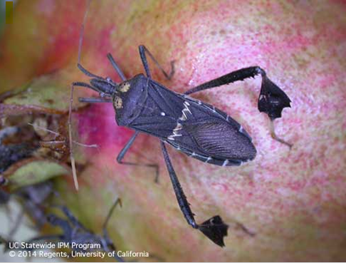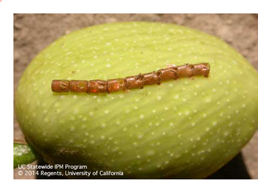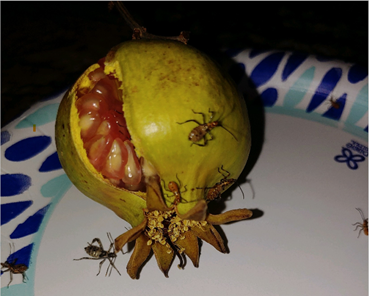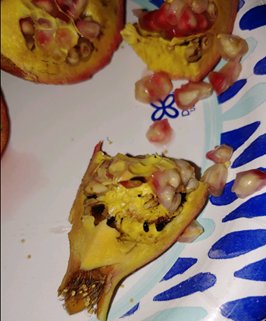Leaffooted bugs have a narrow brown body with a length of .75 to 1 inch long. They feed on fruits, fruiting vegetables, ornamentals and nuts. They have piercing-sucking mouth parts that help them feed on plant parts and particularly seeds. Leaffooted bugs have small leaf-like enlargements on their hind legs.
There are three common, native species to California and the Western United States. These include the Leptoglossus zonatus, L. clypealis, and L. occidentalis. All three are similar in appearance with a white zigzag pattern across the wings. But, the main difference in appearance between the three are:
- L. zonatus has two yellow spots just behind the head.
- L. clypealis has a sharp, pointed projection, called a clypeus, pointing forward from the tip of the head.
- L. occidentalis has neither of these features
L. zonatus – courtesy of UC statewide IPM
L. occidentalis also known as the western conifer seed bug is predominately found near conifers. L. clypealis is typically found on desert plants like the Joshua tree, yuccas, and palms.
Leaffooted bugs have two to three generations per year, especially in areas with mild winter temperatures. Adults lay eggs in host plants. Host plants in our area can include young citrus, almonds, pistachios, tomato plants, watermelons and pomegranates.
Courtesy of UC Statewide IPM
Leaffooted nymphs
Adult Leaffooted bugs overwinter in outbuildings, woody areas, Eucalyptus bark, cracks in trees. They emerge in March or April and are strong flyers who fly off in search of food. As stated above, they have many generations per year with each adult laying nearly 200 eggs. Overwintered adults live long and can even survive to see their offspring the following spring.
Piercing- sucking mouth parts of these bugs can be long, even up to half the size of the bug. Nymphs feed on superficial plant juices. Adults can feed deeply into the fruit in search of the seeds. If the seed is hard like an almond, the bug secretes digestive enzymes to soften the seed, so that it is digestible. Leaffooted bugs can also carry a fungal yeast called Eremothecium coryli. This yeast does not cause enough damage to prevent harvest and is not problematic for consumption. When the bugs feed in the early season on almonds and other hard seeds, digestive enzymes can cause the fruit to abort and die. Late-season feeding on pomegranates can cause the arils to discolor and wither. Damage I have seen periodically can be extensive in pomegranates with the entire interior black and inedible. Since Eremothecium coryli isn't typically the culprit, the entry wound from feeding bugs can allow other molds to enter the fruit and cause this extensive damage.
Usually, Leaffooted bugs don't have a large enough population to do significant damage. Cleaning up overwintering areas are best for prevention of large populations. At my house, many of the adults may be overwintering in the pomegranates, so trimming dense branching, raking under trees and picking off and disposing of fruit “mummies” will dramatically reduce populations for the next year. Also, a milder winter will allow populations to flourish as cold temperatures kill the adults.
There are natural enemies like a tiny wasp called Gryon pennsylvanicum. Adult Leaffooted bugs can occasionally be parasitized by certain tachinid flies. Birds and spiders also will eat these bugs.
There are a few reasons that pesticide use isn't recommended. One reason is that the ideal application time of the pesticide on the fruit to the harvest time isn't long enough. Another is that most pesticides only kill the nymphs. And lastly, the most effective pesticide is pyrethroid- based which kills bees and other beneficial insects. Also, Botanicals, Neem oil and insecticidal soap are only effective on nymphs.
I have quite a large number of Leaffooted bugs this year. I will be hand-picking the bugs and either smashing them or will drop them into water and drown them.
Sources:



